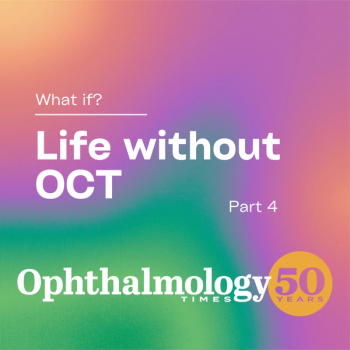
Are intracameral antibiotics the answer for endophthalmitis?
Postoperative endophthalmitis remains a potentially devastating complication of cataract surgery. However, a good visual outcome is possible if the infection is recognized early and treated appropriately, said Harry W. Flynn Jr, MD.
Reviewed by Harry W. Flynn Jr, MD, and Nidhi Relhan, MD
Miami, FL-Postoperative endophthalmitis remains a potentially devastating complication of cataract surgery. However, a good visual outcome is possible if the infection is recognized early and treated appropriately, said Harry W. Flynn Jr, MD.
He provided an overview of the classification, manifestations, etiology, prophylaxis, and management of post-cataract surgery endophthalmitis.
Figure 1: 60-year-old male with acute-onset postoperative endophthalmitis 5 days following complicated cataract surgery with ACIOL. Note the conjunctival hyperemia, corneal edema, hypopyon and fibrin in the anterior chamber. Pars plana vitrectomy and intraocular antibiotics were performed. Images courtesy of Harry W. Flynn Jr, MD
Dr. Flynn said that endophthalmitis after cataract surgery is divided into acute-onset and delayed-onset cases based on whether the event occurs within 6 weeks of the procedure or later. Acute-onset endophthalmitis presents with ocular redness, pain, hypopyon, and fibrin in the anterior chamber, and is most often due to Gram-positive bacteria, with coagulase-negative staphylococci being the most common pathogen.
Recent:
Patient- and surgery-related features that increase the risk of acute-onset endophthalmitis include significant blepharitis or lid abnormalities, relative immune compromise (e.g., diabetes, older age), incision leak, intraoperative vitreous loss, application of lidocaine gel prior to povidone-iodine preparation of the ocular surface, and contaminated solutions introduced into the anterior chamber.
Related:
Delayed-onset endophthalmitis usually follows an indolent course in which inflammation gradually progresses, leading to vitritis and infiltrates in the vitreous cavity. Hypopyon is less common with delayed-onset endophthalmitis compared with acute-onset endophthalmitis, but infection in the capsular bag manifested by the appearance of white plaques is seen more often with delayed-onset endophthalmitis.
Related:
“Despite treatment, there can be infection recurrence in these cases that may necessitate removal of the intraocular lens (IOL) and capsular bag,” said Dr. Flynn, professor of ophthalmology and The J. Donald M. Gass Distinguished Chair in Ophthalmology, Bascom Palmer Eye Institute, University of Miami.
Propionibacterium acnes are the most common cause of delayed-onset endophthalmitis, and fungi, particularly Candida spp., are also important in the etiology of these infections.
Prophylaxis
In the United States, topical antibiotics started before surgery and continued postoperatively are used as endophthalmitis prophylaxis for patients undergoing cataract surgery. Although use of a topical antibiotic may be considered by some to be standard of care for preventing endophthalmitis after cataract surgery, Dr. Flynn noted that evidence-based data demonstrating its efficacy is controversial.
“There are studies showing topical antibiotics may lower the rates of endophthalmitis by reducing colony counts on the ocular surface” he said.
Related:
Dr. Flynn pointed out that topical antibiotic treatment could be a relatively expensive option for endophthalmitis prophylaxis. Increasing resistance of endophthalmitis pathogens to commonly used antibiotics is another potential limitation.
This trend is highlighted by the findings of a study in which Dr. Flynn and colleagues analyzed the susceptibility of coagulase-negative, staphylococci endophthalmitis isolates from patients treated at the University of Miami from 1990 to 2014. The data showed that during the years 2005 to 2014, bacterial resistance rates using ciprofloxacin, moxifloxacin, and levofloxacin were about 60%.
Intracameral approach
Intracameral antibiotic injection is another approach used to reduce the risk of postoperative endophthalmitis. The efficacy of intracameral cefuroxime was demonstrated in the landmark study from the European Society of Cataract and Refractive Surgeons.1 It has been corroborated by data from other studies comparing cohorts of patients receiving and not receiving intracameral cefuroxime2,3, Dr. Flynn said.
More cataract:
Figure 2. At 6 months after management, the inflammation subsided with visual acuity of 20/50. Images courtesy of Harry W. Flynn Jr, MDLarge cohort studies are limited by changes in techniques and equipment in earlier years, compared with more recent cases.4
Recent:
Resistance of important endophthalmitis pathogens is also an issue with cefuroxime.5 Furthermore, there is no commercially available preparation of cefuroxime for intracameral use available in the United States, and the need for compounding the solution for injection introduces risks of dilution errors, contamination, and toxic anterior segment syndrome (TASS).6-8
Related:
Vancomycin is also being used intracamerally for endophthalmitis prophylaxis. This practice is concerning after recent reports associating it with the development of hemorrhagic occlusive retinal vasculitis (HORV)9 and considering the potential to promote bacterial resistance to vancomycin.10
With regard to the latter issue, Dr. Flynn cited the Centers for Disease Control Hospital Infection Control Practices Advisory Committee’s Recommendations for Preventing the Spread of Vancomycin Resistance.11 Its list of situations in which vancomycin use should be discouraged include both routine surgical prophylaxis and topical application or irrigation.
Recent:
“We are living in an era of antibiotic stewardship12 where more and more, we are being scrutinized by the government and other healthcare agencies as to antibiotics we utilize during our surgery,” Dr. Flynn said. “We must keep in mind the risks, benefits, costs, and antibiotic stewardship in deciding whether or not to utilize intracameral antibiotics.13”
“Dropless cataract surgery” in which triamcinolone plus moxifloxacin with or without vancomycin is injected into the anterior vitreous via a transzonular approach using a long, 27- or 30-gauge cannula represents a novel approach during cataract surgery.14 Discussing the potential downsides of this method, Dr. Flynn listed concerns about bacterial resistance, compounding errors, steroid-induced glaucoma, lens subluxation and dislocation, and patient complaints of blurred vision for one or more weeks following surgery.
Treating endophthalmitis
When treating a patient in an outpatient clinic, Dr. Flynn said he aspirates a vitreous sample and injects antibiotic into the vitreous using a 23-gauge butterfly needle attached to a 10-cc syringe to enter the posterior segment through the pars plana. If the patient has been taken to the operating room, he used a syringe attached directly to the small-gauge vitrectomy probe to collect the vitreous sample.
Editorial:
His antibiotic regimen for treating acute-onset endophthalmitis combines vancomycin 1 mg/0.1 ml and ceftazidime 0.25 mg/0.1 ml. As long as fungal infection is not suspected, he also injects dexamethasone 0.4 mg/0.1 ml into the vitreous cavity. Subconjunctival injection with vancomycin 25 mg with or without ceftazidime 100 mg may also be administered in more advanced cases.
Harry W. Flynn Jr, MD
Nidhi Relhan, MD
Dr. Flynn and Dr. Relhan have no relevant financial interests to disclose.
References
1. Prophylaxis of postoperative endophthalmitis following cataract surgery: results of the ESCRS multicenter study and identification of risk factors. J Cataract Refract Surg. Jun 2007;33(6):978-988.
2. Herrinton LJ, Shorstein NH, Paschal JF, et al. Comparative effectiveness of antibiotic prophylaxis in cataract surgery. Ophthalmology. Feb 2016;123(2):287-294.
3. Creuzot-Garcher C, Benzenine E, Mariet AS, et al. Incidence of acute postoperative endophthalmitis after cataract surgery: a nationwide study in France from 2005 to 2014. Ophthalmology 2016 Mar 16. Pii: S0161-6420(16)00200-1 [Epub ahead of print], http://dx.doi.org/10.1016/j.ophtha.2016.02.019.
4. Coleman AL. How Big Data Informs Us About Cataract Surgery: The LXXII Edward Jackson Memorial Lecture. American journal of ophthalmology. 2015;160(6):1091-1103. e1093.
5. Ness T, Kern WV, Frank U, Reinhard T. Postoperative nosocomial endophthalmitis: is perioperative antibiotic prophylaxis advisable? A single centre's experience. J Hosp Infect. Jun 2011;78(2):138-142.
6. Delyfer MN, Rougier MB, Leoni S, et al. Ocular toxicity after intracameral injection of very high doses of cefuroxime during cataract surgery. J Cataract Refract Surg. Feb 2011;37(2):271-278.
7. Cakir M, Imamoglu S, Cekic O, et al. An outbreak of early-onset endophthalmitis caused by Fusarium species following cataract surgery. Curr Eye Res. Nov 2009;34(11):988-995.
8. Mamalis N, Edelhauser HF, Dawson DG, Chew J, LeBoyer RM, Werner L. Toxic anterior segment syndrome. J Cataract Refract Surg. Feb 2006;32(2):324-333.
9. Witkin AJ, Shah AR, Engstrom RE, et al. Postoperative hemorrhagic occlusive retinal vasculitis: expanding the clinical spectrum and possible association with vancomycin. Ophthalmology. Jul 2015;122(7):1438-1451.
10. Relhan N, Albini TA, Pathengay A, Kuriyan AE, Miller D, Flynn HW. Endophthalmitis caused by Gram-positive organisms with reduced vancomycin susceptibility: literature review and options for treatment. Br J Ophthalmol. Apr 2016;100(4):446-452.
11. CDC issues recommendations for preventing spread of vancomycin resistance. Am J Health Syst Pharm. Jun 15 1995;52(12):1272-1274.
12. Spellberg B, Srinivasn A, Chambers HF. New societal approaches to empowering antibiotic stewardship. JAMA. Feb 25 2016 Feb 25.
13. Schwartz SG, Flynn HW, Jr., Grzybowski A, Relhan N, Ferris FL. Intracameral antibiotics and cataract surgery: endophthalmitis rates, costs and stewardship. Ophthalmology. 2016 Mar.
14. Stringham JD, Flynn HW, Jr., Schimel AM, Banta JT. Dropless cataract surgery: what are the potential downsides? Am J Ophthalmol. Apr 2016;164:viii-x.
Newsletter
Don’t miss out—get Ophthalmology Times updates on the latest clinical advancements and expert interviews, straight to your inbox.



















































.png)


